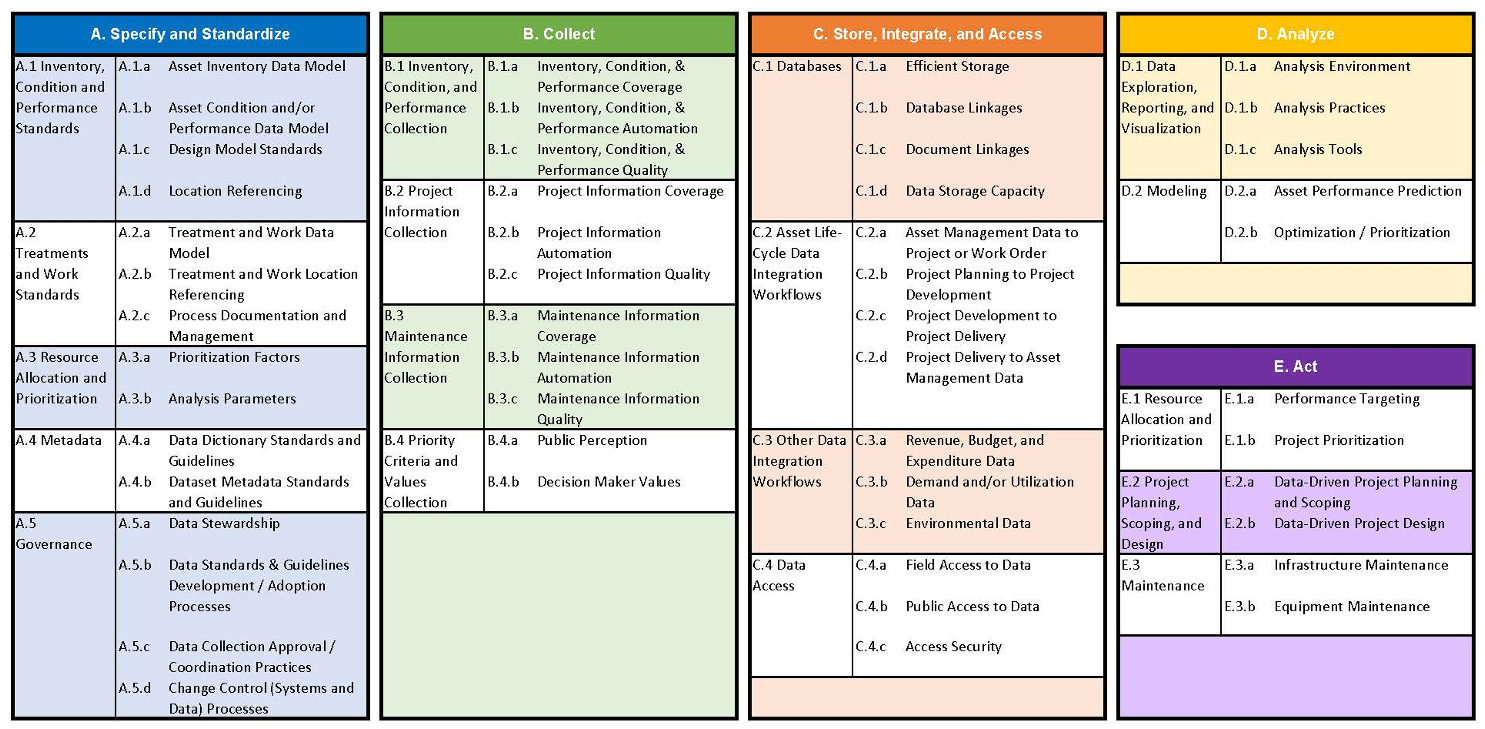3. Self-Assessment and Improvement Identification
This chapter provides detailed supporting materials for assessment and improvement identification. This content is organized around the five Areas of the data life-cycle.
Self-Assessment Framework and Materials Overview
This section details the technical framework used to organize the assessment and improvement identification materials, and provides Area- and Section-specific materials to support the assessment process.
Figure 3-1. Guidance Framework
Figures 3-1 and 3-2 provides a representation of the complete data life-cycle framework, comprised of 5 Areas, 18 Sections, and 51 Elements.
See the Full Section
Area A – Specify and Standardize Data
Establish asset, treatment, and work data standards, standard prioritization factors, metadata standards, and comprehensive governance programs.
A.1
Inventory, Condition, and Performance Standards
Asset inventory, condition, and performance data models, as well as supporting design and location referencing standards.
A.2
Treatments and Work Standards
Asset treatment and work data models, as well as the supporting design and location referencing standards.
A.3
Resource Allocation and Prioritization
Definition of standardized prioritization factors and analysis parameters.
A.4
Metadata
Data set-level and data element (data dictionary) metadata standards and guidelines.
A.5
Governance
Roles, responsibilities and processes for adoption of data standards and guidelines, data change control, and data collection approval and coordination practices.
Improvements in this Area aim at specifying data requirements to align with agency business needs, standardizing data models so that information from different systems can be integrated and aggregated for analysis and reporting, and formalizing roles and processes to ensure alignment and coordination across different stakeholders.
Explore this Area
Area B – Collect Data
Collection of asset inventory, condition and performance, treatment and work history, and external decision-maker and public perception in a manner that can be incorporated into DOT TAM programs.
B.1
Inventory, Condition, and Performance Collection
Collection of asset inventory, condition, and performance data - with specific consideration of coverage, automation, and quality.
B.2
Project Information
Collection of project work accomplishments to update asset inventory and maintain work history for specific assets - with focus on collection coverage, automation, and quality.
B.3
Maintenance Information
Maintenance Information: Collection of maintenance work accomplishments to update asset inventory and maintain work history for specific assets - with focus on collection coverage, automation, and quality.
B.4
Priority Criteria and Values
Capture of public perception and decision-maker values to help guide DOT TAM decision-making.
Improvements in this Area are aimed at advancing methods for collecting and assuring the quality of key data supporting TAM analysis, reporting, and decision-making, Improvements may include deployment of innovative technology solutions, as well as improved quality control and assurance techniques and streamlined business processes.
Explore this Area
Area C – Store, Integrate, and Access Data
Structuring, integrating and providing access to data to support TAM operations, management and reporting needs.
C.1
Databases
Designing TAM databases to support efficient and effective storage of and access to contained data and documentation.
C.2
Asset Life-Cycle Data Integration Workflows
Efficient exchange of information across various business processes, tools, and systems involved in the complete asset life-cycle, from project planning through delivery and ongoing asset management and operation.
C.3
Other Data Integration Workflows
Efficient exchange of information between asset management and financial and other supporting business systems and practices.
C.4
Data Access
Ability of agency field staff and the general public to efficiently and securely access TAM information.
Improvements in this Area are aimed at managing asset data in an efficient manner and integrating data across systems supporting different assets and different asset life-cycle phases and agency business processes.
Explore this Area
Area D – Analyze Data
Establish decision-support tools, techniques, and practices to develop actionable information and insights to support decision-making.
D.2
Modeling
Presenting specific asset performance prediction and TAM investment optimization and prioritization methodologies which can be supported through data analysis.
Improvements in this Area are aimed at advancing practices for transforming raw data into information that can support decision making.
Explore this Area
Area E – Act Informed by Data
Application of data and information systems, processes, tools, and techniques to TAM decision-making, including performance targeting and prioritization programs, project-level scoping and design, as well as infrastructure and equipment maintenance practices.
E.1
Resource Allocation and Prioritization
Addressing how data is applied within TAM performance targeting and project prioritization.
E.2
Project Planning, Scoping, and Design
Presenting how project planning and scoping, as well as design are informed by data.
E.3
Maintenance
Capturing how available data is incorporated into agency infrastructure and equipment maintenance practices.
Improvements in this Area are aimed at better integrating use of data and information within TAM processes including network-level investment decision-making, project-level prioritization and development, and routine maintenance decisions.
Explore this Area

